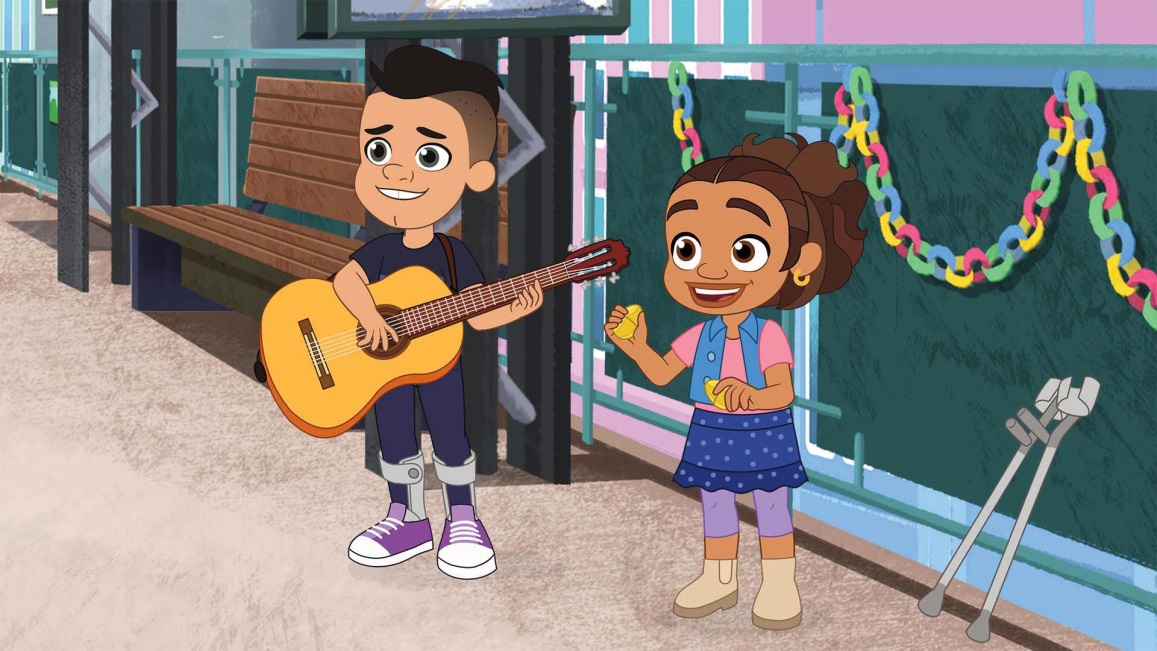
HEY MAMBO: (Opposite page) Eddie is not only a child with cerebral palsy, he has interests such as music, dance, baseball, and soccer. (Above) Eddie has a family, friends, schoolmates, and teammates, and is depicted as a helpful, enthusiastic, talented boy.
in most settings and to climb stairs with the aid of a railing. Such children may ambulate with physical assistance, a handheld mobility device or use wheeled mobility over long distances. They have only minimal ability to perform gross motor skills such as running and jumping (Palisano, R. et al, 1997).
As the medical consultant, I assess story scripts and preliminary drawings and videos of Eddie participating in various activities. The process of doing so has broadened my own horizons to consider the total functional tasks for a child with cerebral palsy. The child with cerebral palsy needs to do more than lie on an examination table to undergo range of motion assessment and maneuver up and down a clinic hallway. The child with cerebral palsy lives in a home, goes to school, participates in play and service activities in their community. During the course of my work for the show, I have faced very specific questions, such as: How does Eddie comfortably kneel while wearing his ankle foot orthotics (leg braces)? How does he safely splash in a puddle while using his crutches? Wrestling with such questions provided me with increased awareness of both the capabilities and the challenges faced by a child with cerebral palsy.
The portrayal of a child with cerebral palsy in Alma's Way provides a viewer with cerebral palsy with a sense of representation, of acknowledgment. Eddie is not only a child with cerebral palsy, he is a son, a cousin, a friend, a teammate, a musician. He has interests: music, dance, baseball, and soccer among them. Sometimes, accommodations are needed for him to pursue his interests, but pursuit of his interests still is possible, even enjoyable. Eddie gives to his family, friends, teammates, and community.
The portrayal of a child with cerebral palsy gives a child with
out motor challenges increased awareness and acceptance of differences. The child with cerebral palsy is seen as a person who can do many things, sometimes with accommodations or assistance. This child shares many of the same interests as the unaffected child. Like the unaffected child, the child with cerebral palsy has a family, friends, schoolmates, teammates. Eddie Mambo is depicted as a helpful, enthusiastic, talented boy. His walking challenges do not diminish these, or other positive qualities he possesses. Any child watching the show could want to have Eddie Mambo as a friend. In the future, would a viewer of Alma's Way wish to befriend a child with cerebral palsy whom they might encounter? I certainly hope so. Two lives could be greatly enriched through such a friendship. Facilitating such mutual enrichment is one of the goals for those who work on Alma's Way. I am grateful to have been part of such an effort. •
New episodes of Alma's Way will be premiering from July 11 to July 14.
References
Palisino, R.; Rosenbaum, P.; Walter, S.; Russel, D.; Wood, E.; Galuppi, B. Developmental and reliability of a system to classify gross motor function in children with cerebral palsy. Dev.Med. Child Neurol. 1997, 39, 214-223.
ABOUT THE AUTHOR:
Dr. Mary Louise Russell is a pediatric rehabilitation physician at the West Virginia University Medical Center. She has also worked with children who have conditions that adversely affect their ability to move at the Children's Hospital and The Children's Institute in Pittsburgh, where watching children in their therapy sessions has been a joyful part of her duties. Dr. Russell completed a pediatrics residency at Children's Hospital of Columbus, OH, and a physical medicine and rehabilitation residency at the University of Minnesota Medical Center. She attended medical school at the Medical College of Pennsylvania.